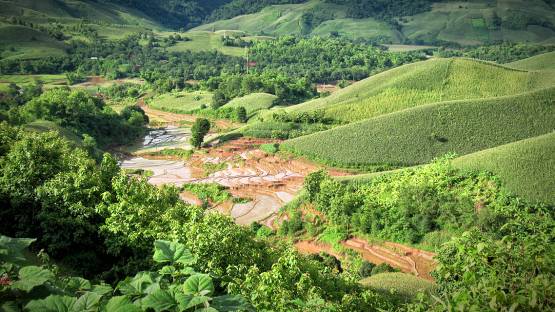Nuclear techniques are making a significant contribution to climate-smart agriculture, by helping to combat soil erosion, improve soil fertility, crop water use efficiency and crop yields, said speakers at an IAEA General Conference side event yesterday, in celebration of the 2015 International Year of Soils.
Under the slogan ‘Healthy soils for a healthy life,’ the 2015 International Year of Soils provides the global community with the space to increase the awareness and understanding of the importance of soil for food security and essential ecosystem functions. Many countries are developing ‘climate-smart agriculture’ practices, including the use of nuclear and isotopic techniques. The IAEA helps Member States in using these techniques to improve soil and water management practices, with concrete development results for farmers.
“Managing soils is key to addressing climate change,” said Joseph Mureithi, Deputy Director General of the Kenya Agricultural and Livestock Research Organization (KALRO). “Advanced water irrigation techniques, have improved the lives of pastoral communities.”
One of these techniques is drip irrigation, which KALRO introduced with the help of nuclear techniques that measure soil water and fertilizer use efficiency , enabling farmers to work out exactly how much water and nutrients to use and when. While drip irrigation uses significantly lower quantities of water for agriculture, saving precious resources, this information is often not known by small-scale farmers. This is particularly important in times of drought, which are more and more frequent in large parts of Kenya as a result of climate change.
In Viet Nam, adopting appropriate soil conservation practices following erosion measurement using nuclear techniques has led to a 45 per cent reduction in soil erosion in the areas where it was applied, said Anh Tuan Hoang, Director General of Viet Nam’s Atomic Energy Agency (VAEA). In Viet Nam, where three quarters of the country’s territory is sloping land, erosion is a major problem. VAEA, with IAEA support, obtained detailed soil erosion data with the help of fallout radionuclides, which help to assess erosion rates. Subsequent compound specific stable isotope analysis enabled scientist to trace critical areas of land degradation. Knowing the sources of erosion allows farmers to employ mitigation techniques, such as intercropping, cover crops and terracing to minimize the losses. “Nuclear technology plays a key role in assessing land erosion to implement best farming practices,” he said.
Telling the future
“Nuclear and isotopic techniques allow us to reconstruct past climate and environmental conditions, in order to better project the future climate patterns affecting agriculture,” said Heitor Evangelista Da Silva, Professor, Universidade do Estado de Rio De Janerio in Brazil who presented on soils and sediments as a rich source of information on agro-ecosystems. This information can be used to predict trends of prolonged droughts but also soil erosion processes for improving the management of food and agriculture in the future.
It is estimated that 52% of land used for agriculture is moderately or severely affected by soil degradation. Soils are a limited resource that host one quarter of the planet’s biodiversity; yet the amount of fertile soil on the planet, which takes hundreds to thousands of years to form one centimetre of soil, has been diminishing at an alarming rate. It is expected that soil loss further increases due to a changing climate.
“We need to work together and move forward to address climate change,” said Liang Qu, Director of the Joint FAO/IAEA Division of Nuclear Techniques in Food and Agriculture. “No single country, no single organization will be able to do it alone. Nuclear and isotopic techniques can play important roles in climate-smart agriculture. In addition, more R&D activities are needed to improve our understanding of the impact of climate change.”
The importance of soil for humanity is often underestimated, added Gerd Dercon, Head of the Soil and Water Management and Crop Nutrition Laboratory at the Joint FAO/IAEA Division. “We all depend on soils for human food, animal feed, fibre and fuel production.” he said. “Soil is a treasure box storing carbon and preventing it from being released into the atmosphere as carbon dioxide,” more organic carbon is stored in the soil than in atmosphere and vegetation combined.”
As the international community continues exploring the importance of soil and its conservation, international representatives will meet at the IAEA on 7 December 2015 to look at the past achievements, the future challenges and the opportunities for international cooperation to manage and conserve soil resources, on the occasion of World Soil Day as part of the final Celebration of the International Year of Soils 2015. Several high level representatives from the Royal Family of Thailand, FAO, IAEA, the European Commission, the Austrian government and scientific partners will participate in this event, jointly organized with the International Union of Soil Science (IUSS).




